Abstract
Fast breathing has been recommended as a predictor of childhood pneumonia. Children living at high altitude, however, may breathe faster in response to the lower oxygen partial pressure, which may change the accuracy of prediction of a high respiratory rate. To assess the usefulness of clinical manifestations in the diagnosis of radiological pneumonia or hypoxaemia, or both, at high altitude (2640 m above sea level), 200 children aged 7 days to 36 months presenting to an urban emergency room with cough lasting less than seven days were studied. Parents were interviewed and the children evaluated using standard forms. The results of chest radiographs and pulse oximetry obtained after clinical examination were interpreted blind. Radiological pneumonia and haemoglobin oxygen saturation < 88% were used as 'gold standards'. One hundred and thirty (65%) and 125 (63%) children had radiological pneumonia and hypoxaemia respectively. Crepitations and decreased breath sounds were statistically associated with pneumonia, and rapid breathing as perceived by the child's mother, chest retractions, nasal flaring, and crepitations with hypoxaemia. The best single predictor of the presence of pneumonia is a high respiratory rate, although the results are not as good as those reported by other studies. A respiratory rate > or = 50/minute had good sensitivity (76%) and specificity (71%) for hypoxaemia in infants. Hypoxaemia had a good sensitivity and specificity for pneumonia mainly in infants (83% and 73%, respectively). Logistic regression analysis showed that decreased or increased respiratory sounds and crepitations were associated with pneumonia, and that hypoxaemia is the best predictor when auscultatory findings are excluded. These results suggest that some clinical predictors appear to be less accurate in Bogota than in places at lower altitude, and that pulse oximetry can be used for predicting pneumonia.
Full text
PDF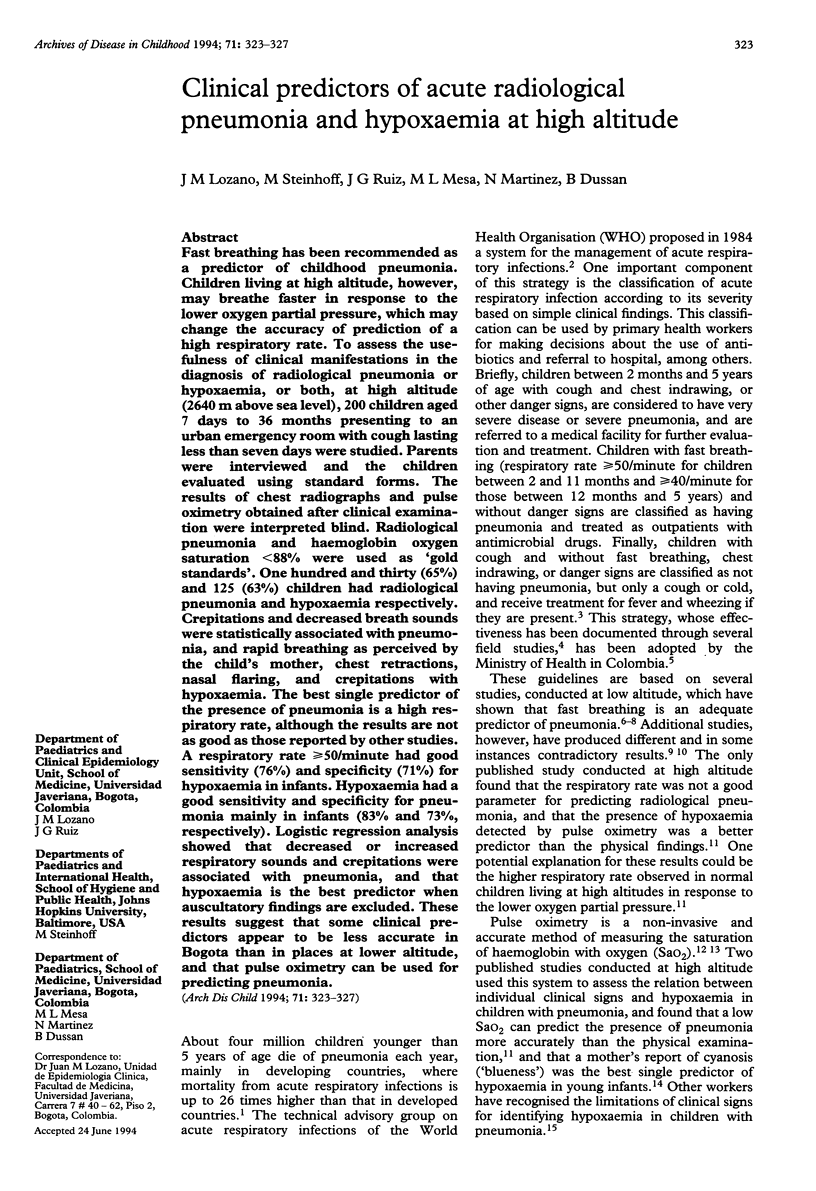
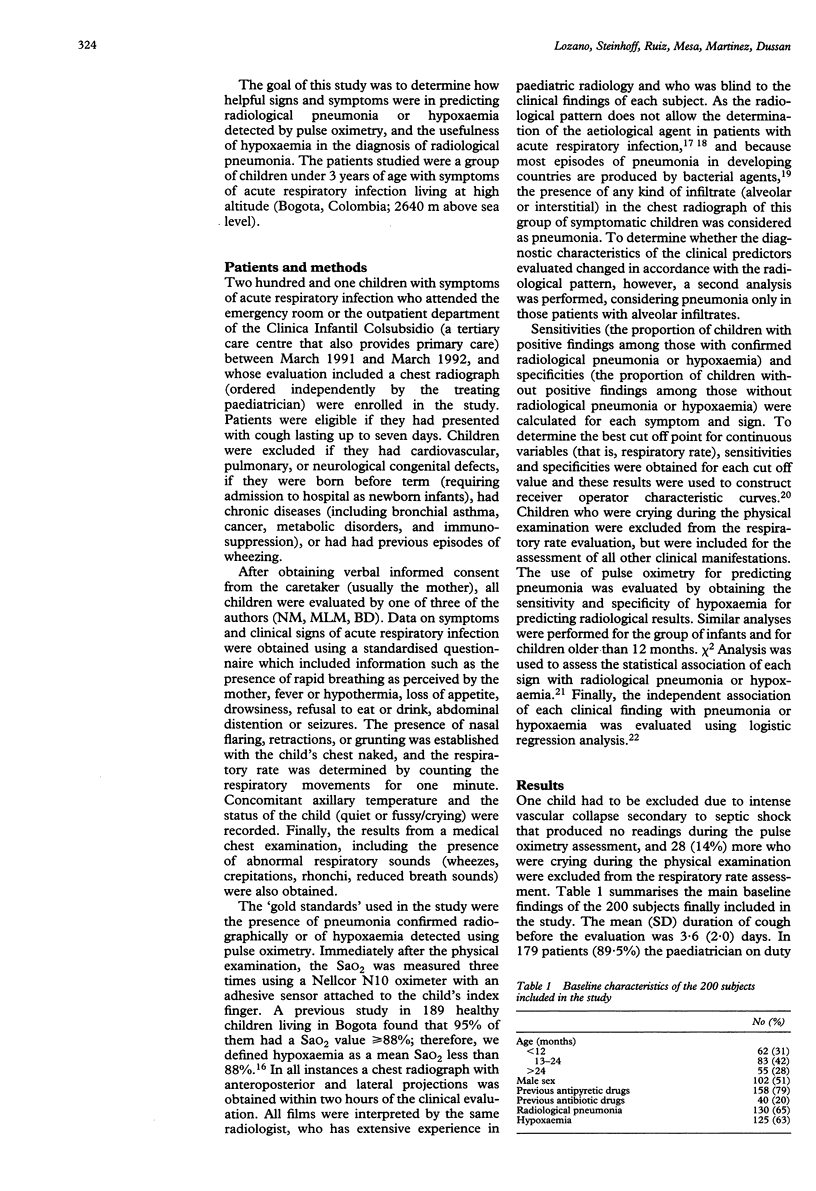
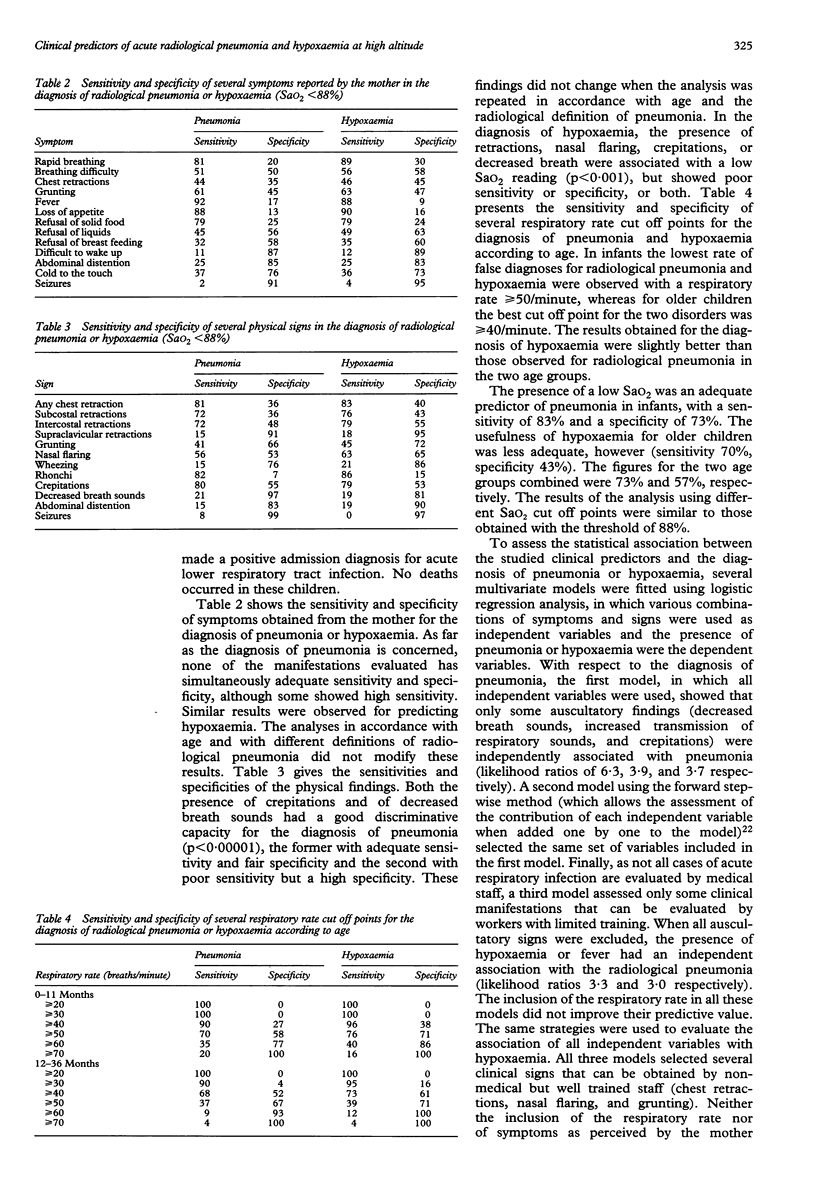
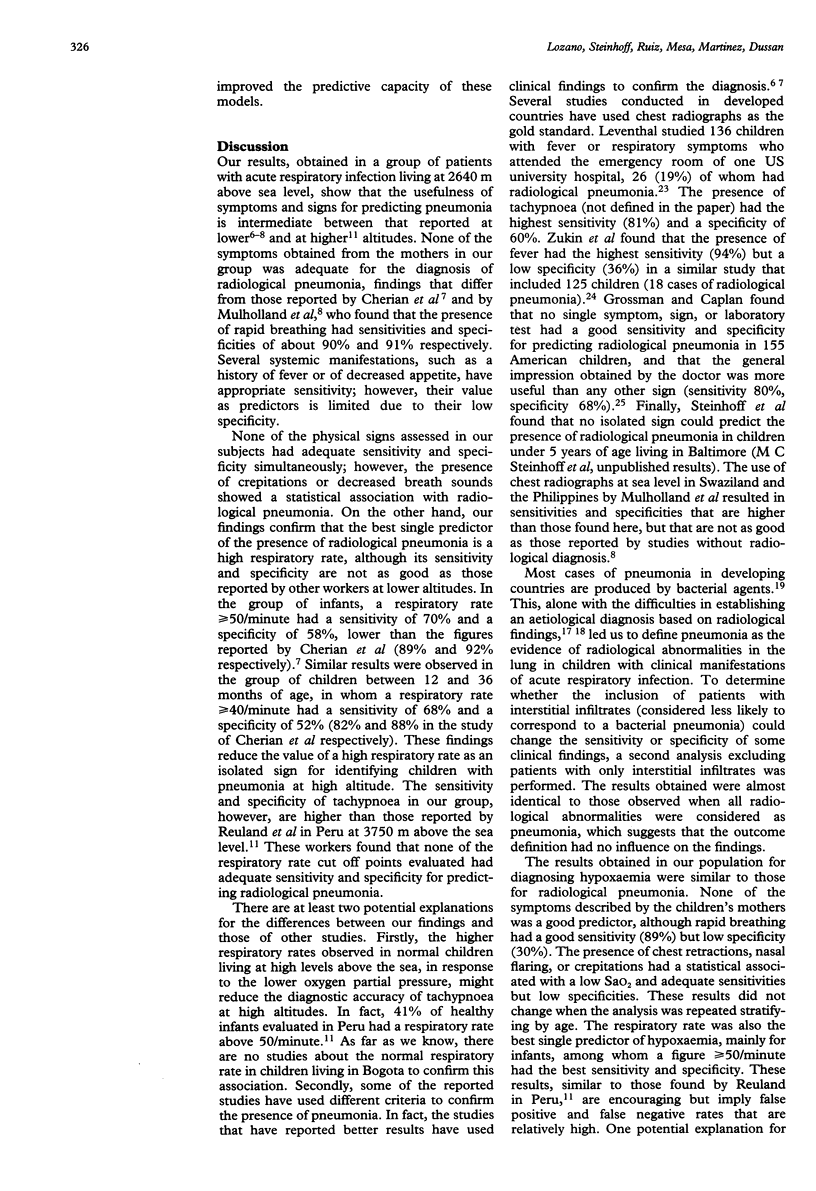
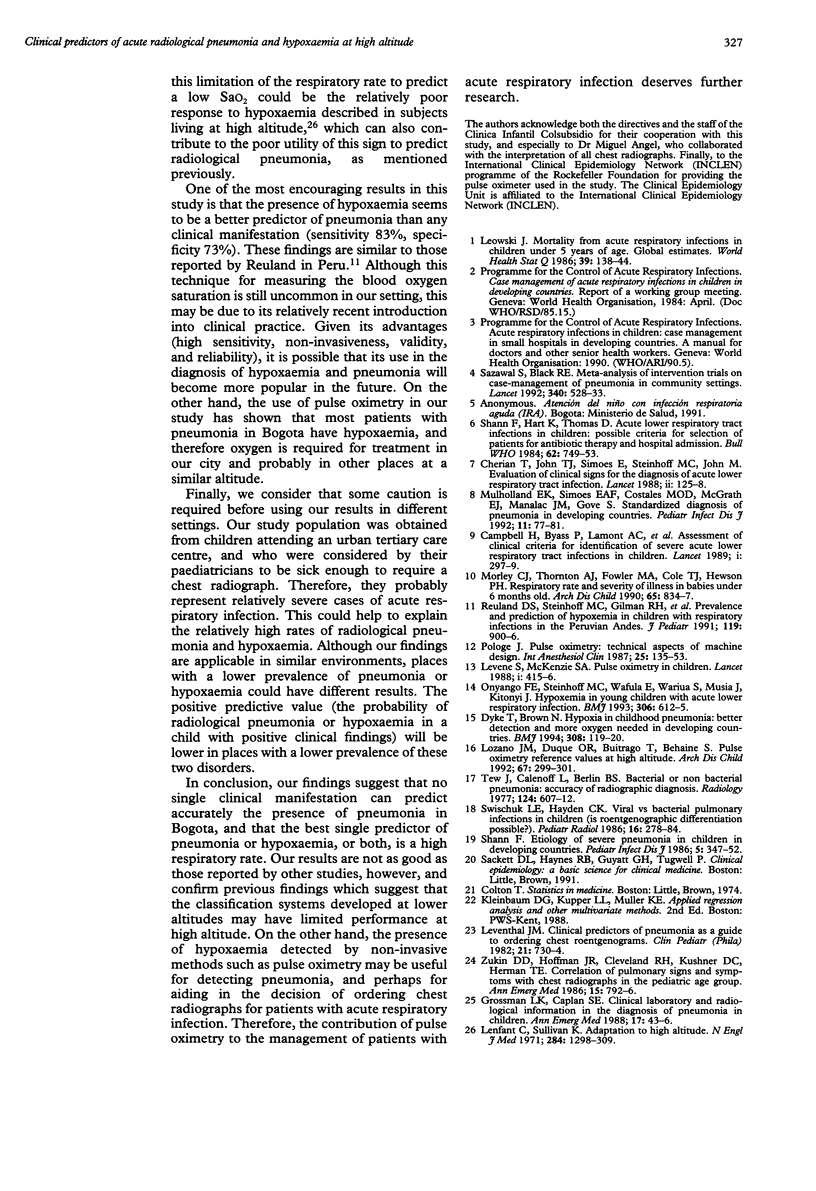
Selected References
These references are in PubMed. This may not be the complete list of references from this article.
- Campbell H., Byass P., Lamont A. C., Forgie I. M., O'Neill K. P., Lloyd-Evans N., Greenwood B. M. Assessment of clinical criteria for identification of severe acute lower respiratory tract infections in children. Lancet. 1989 Feb 11;1(8633):297–299. doi: 10.1016/s0140-6736(89)91308-1. [DOI] [PubMed] [Google Scholar]
- Cherian T., John T. J., Simoes E., Steinhoff M. C., John M. Evaluation of simple clinical signs for the diagnosis of acute lower respiratory tract infection. Lancet. 1988 Jul 16;2(8603):125–128. doi: 10.1016/s0140-6736(88)90683-6. [DOI] [PubMed] [Google Scholar]
- Dyke T., Brown N. Hypoxia in childhood pneumonia: better detection and more oxygen needed in developing countries. BMJ. 1994 Jan 8;308(6921):119–120. doi: 10.1136/bmj.308.6921.119. [DOI] [PMC free article] [PubMed] [Google Scholar]
- Grossman L. K., Caplan S. E. Clinical, laboratory, and radiological information in the diagnosis of pneumonia in children. Ann Emerg Med. 1988 Jan;17(1):43–46. doi: 10.1016/s0196-0644(88)80502-x. [DOI] [PubMed] [Google Scholar]
- Leowski J. Mortality from acute respiratory infections in children under 5 years of age: global estimates. World Health Stat Q. 1986;39(2):138–144. [PubMed] [Google Scholar]
- Levene S., McKenzie S. A. Pulse oximetry in children. Lancet. 1988 Feb 20;1(8582):415–416. doi: 10.1016/s0140-6736(88)91209-3. [DOI] [PubMed] [Google Scholar]
- Leventhal J. M. Clinical predictors of pneumonia as a guide to ordering chest roentgenograms. Clin Pediatr (Phila) 1982 Dec;21(12):730–734. doi: 10.1177/000992288202101205. [DOI] [PubMed] [Google Scholar]
- Lozano J. M., Duque O. R., Buitrago T., Behaine S. Pulse oximetry reference values at high altitude. Arch Dis Child. 1992 Mar;67(3):299–301. doi: 10.1136/adc.67.3.299. [DOI] [PMC free article] [PubMed] [Google Scholar]
- Morley C. J., Thornton A. J., Fowler M. A., Cole T. J., Hewson P. H. Respiratory rate and severity of illness in babies under 6 months old. Arch Dis Child. 1990 Aug;65(8):834–837. doi: 10.1136/adc.65.8.834. [DOI] [PMC free article] [PubMed] [Google Scholar]
- Mulholland E. K., Simoes E. A., Costales M. O., McGrath E. J., Manalac E. M., Gove S. Standardized diagnosis of pneumonia in developing countries. Pediatr Infect Dis J. 1992 Feb;11(2):77–81. doi: 10.1097/00006454-199202000-00004. [DOI] [PubMed] [Google Scholar]
- Onyango F. E., Steinhoff M. C., Wafula E. M., Wariua S., Musia J., Kitonyi J. Hypoxaemia in young Kenyan children with acute lower respiratory infection. BMJ. 1993 Mar 6;306(6878):612–615. doi: 10.1136/bmj.306.6878.612. [DOI] [PMC free article] [PubMed] [Google Scholar]
- Reuland D. S., Steinhoff M. C., Gilman R. H., Bara M., Olivares E. G., Jabra A., Finkelstein D. Prevalence and prediction of hypoxemia in children with respiratory infections in the Peruvian Andes. J Pediatr. 1991 Dec;119(6):900–906. doi: 10.1016/s0022-3476(05)83040-9. [DOI] [PubMed] [Google Scholar]
- Sazawal S., Black R. E. Meta-analysis of intervention trials on case-management of pneumonia in community settings. Lancet. 1992 Aug 29;340(8818):528–533. doi: 10.1016/0140-6736(92)91720-s. [DOI] [PubMed] [Google Scholar]
- Shann F., Hart K., Thomas D. Acute lower respiratory tract infections in children: possible criteria for selection of patients for antibiotic therapy and hospital admission. Bull World Health Organ. 1984;62(5):749–753. [PMC free article] [PubMed] [Google Scholar]
- Swischuk L. E., Hayden C. K., Jr Viral vs. bacterial pulmonary infections in children (is roentgenographic differentiation possible?). Pediatr Radiol. 1986;16(4):278–284. doi: 10.1007/BF02386862. [DOI] [PubMed] [Google Scholar]
- Tew J., Calenoff L., Berlin B. S. Bacterial or nonbacterial pneumonia: accuracy of radiographic diagnosis. Radiology. 1977 Sep;124(3):607–612. doi: 10.1148/124.3.607. [DOI] [PubMed] [Google Scholar]
- Zukin D. D., Hoffman J. R., Cleveland R. H., Kushner D. C., Herman T. E. Correlation of pulmonary signs and symptoms with chest radiographs in the pediatric age group. Ann Emerg Med. 1986 Jul;15(7):792–796. doi: 10.1016/s0196-0644(86)80374-2. [DOI] [PubMed] [Google Scholar]


